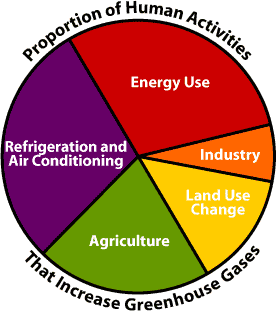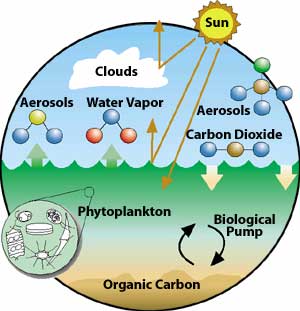
 Atmosphere
Atmosphere
Coral reefs thrive in a very narrow range of temperatures. A sharp increase in water temperatures as seen in El Nino years can cause coral bleaching and eventual death to the coral. Photo: Bleaching occurs when coral become stressed by heat, cold, chemicals, or other factors. Photo courtesy of NOAA.
Some scientists believe that human actions are increasing greenhouse gases (gases like carbon dioxide that let in almost all the sun's radiation, but block much of the outgoing radiation from Earth). They call this global warming. They believe the Earth's atmosphere is getting warmer. If true this could upset the delicate balance of temperatures that coral reefs need to thrive.
 Coral reefs are important in determining the amount of carbon dioxide in the atmosphere. The zooxanthellae algae, through photosynthesis, remove carbon dioxide from the air and make carbohydrates available as food for both the zooxanthellae and the coral polyps. Eventually, much of the carbon removed from the air will reside on the ocean bottom in the form of limestone produced by coral polyps. However, both the coral polyps and the zooxanthellae must also use oxygen through the process of respiration (the same process humans use in breathing). Respiration releases carbon dioxide into the ocean and atmosphere. During the day when photosynthesis is occurring, more oxygen is produced by photosynthesis than carbon dioxide by respiration. At night, however, photosynthesis stops, and only respiration goes on. Most scientists believe coral reefs remove more carbon dioxide from the air than they add—certainly a good thing. Pie Chart: Proportion of human activities that contribute an increase in greenhouse gases.
Coral reefs are important in determining the amount of carbon dioxide in the atmosphere. The zooxanthellae algae, through photosynthesis, remove carbon dioxide from the air and make carbohydrates available as food for both the zooxanthellae and the coral polyps. Eventually, much of the carbon removed from the air will reside on the ocean bottom in the form of limestone produced by coral polyps. However, both the coral polyps and the zooxanthellae must also use oxygen through the process of respiration (the same process humans use in breathing). Respiration releases carbon dioxide into the ocean and atmosphere. During the day when photosynthesis is occurring, more oxygen is produced by photosynthesis than carbon dioxide by respiration. At night, however, photosynthesis stops, and only respiration goes on. Most scientists believe coral reefs remove more carbon dioxide from the air than they add—certainly a good thing. Pie Chart: Proportion of human activities that contribute an increase in greenhouse gases.
 There is some evidence that larger amounts of iron may be deposited in the ocean in the future as global warming
results in more windblown continental dust. Theoretically, sea spray and water vapor form low
There is some evidence that larger amounts of iron may be deposited in the ocean in the future as global warming
results in more windblown continental dust. Theoretically, sea spray and water vapor form low
clouds that ultimately cool temperatures at the surface. Meanwhile, desert dust and carbon dioxide settle into the ocean and act as "fertilizer" to stimulate the growth of phytoplankton, thereby enhancing the ocean's ability to absorb carbon dioxide from the atmosphere—a process known as the "biological pump." Over geological time more than 90 percent of the world's carbon has settled into the deep ocean. Image courtesy of NASA.
Carbon Dioxide
Increased carbon dioxide (CO2) in the atmosphere results in increased carbon dioxide dissolved in seawater. In water CO2 forms a weak acid called carbonic acid. Increased CO2 results in less carbonate (CO3--) available in ocean water. The carbonate ions stay in the weak carbonic acid, H2CO3, making many of them unavailable to form limestone. Additionally, the weak carbonic acid that results from carbon dioxide in solution tends to dissolve already formed limestone. Coral reefs need the carbonate to make the limestone—the basic substance of the hard reef. Experiments have shown that it becomes increasingly difficult for reefs to produce limestone when carbonate concentrations drop.
Climate Change
Earth's climate naturally changes. The Little Ice Age, which persisted from the 14th to the mid-19th century, resulted in temperatures much less than the periods both before and after. Currently, Earth's temperature appears to be increasing. Because coral reefs exist in a very narrow temperature range, these natural climate changes might affect their health.
Anthrosphere | Atmosphere | Biosphere | Hydrosphere | Lithosphere
Glossary ..|.. Related Links ..|.. References |..PBL Model
Home ..|.. Teacher Pages ..|.. Modules & Activities
Maintained by ETE Team
Last updated
March 08, 2004
Privacy Statement and Copyright © 1997-2004 by Wheeling Jesuit University/NASA-supported Classroom of the Future. All rights reserved.
Exploring the Environment®, Coral Reefs was developed under a cooperative agreement with NASA.
Some images © 2004 www.clipart.com
Center for Educational Technologies, Circuit Board/Apple graphic logo, and COTF Classroom of the Future logo are registered trademarks of Wheeling Jesuit University.